
Westchester County is located in the U.S. state of New York. It is the seventh most populous county in the State of New York and the most populous north of New York City. According to the 2020 United States Census, the county had a population of 1,004,456, its highest decennial count ever and an increase of 55,344 (5.8%) from the 949,113 counted in 2010. Westchester covers an area of 450 square miles (1,200 km2), consisting of six cities, 19 towns, and 23 villages. Established in 1683, Westchester was named after the city of Chester, England. The county seat is the city of White Plains, while the most populous municipality in the county is the city of Yonkers, with 211,569 residents per the 2020 census. The county is part of the Hudson Valley region of the state.
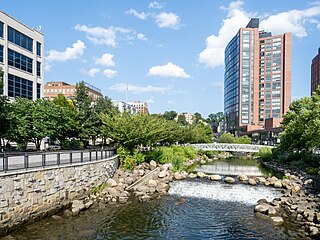
Yonkers is a city in Westchester County, New York, United States. The city, a suburb of the New York metropolitan area, had a population of 211,569 in the 2020 United States census. It is classified as an inner suburb of New York City, north of the Bronx and approximately 2.4 miles (4 km) north of Marble Hill.
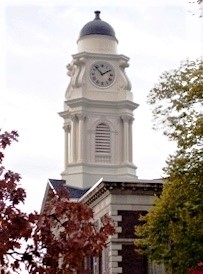
Irvington, sometimes known as Irvington-on-Hudson, is a suburban village in the town of Greenburgh in Westchester County, New York, United States. It is located on the eastern bank of the Hudson River, 20 miles (32 km) north of midtown Manhattan in New York City, and is served by a station stop on the Metro-North Hudson Line. To the north of Irvington is the village of Tarrytown, to the south the village of Dobbs Ferry, and to the east unincorporated parts of Greenburgh, including East Irvington. Irvington includes within its boundaries the community of Ardsley-on-Hudson, which has its own ZIP code and Metro-North station, but which should not be confused with the nearby village of Ardsley.
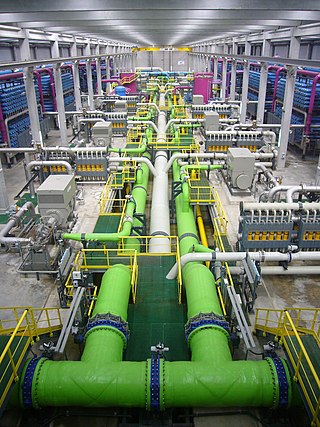
Desalination is a process that takes away mineral components from saline water. More generally, desalination is the removal of salts and minerals from a target substance, as in soil desalination, which is an issue for agriculture. Saltwater is desalinated to produce water suitable for human consumption or irrigation. The by-product of the desalination process is brine. Desalination is used on many seagoing ships and submarines. Most of the modern interest in desalination is focused on cost-effective provision of fresh water for human use. Along with recycled wastewater, it is one of the few rainfall-independent water resources.

The Hudson Valley comprises the valley of the Hudson River and its adjacent communities in the U.S. state of New York. The region stretches from the Capital District including Albany and Troy south to Yonkers in Westchester County, bordering New York City.
Environmental design is the process of addressing surrounding environmental parameters when devising plans, programs, policies, buildings, or products. It seeks to create spaces that will enhance the natural, social, cultural and physical environment of particular areas. Classical prudent design may have always considered environmental factors; however, the environmental movement beginning in the 1940s has made the concept more explicit.

Getty Square is the name for downtown Yonkers, New York, centered on the public square. Getty Square is the civic center, central business district, and transit hub of the City of Yonkers. A dense and growing residential area, it is located in southern Westchester County, New York. The square is named after prominent 19th-century merchant Robert Getty.

Reflective surfaces, or ground-based albedo modification (GBAM), is a solar radiation management method of enhancing Earth's albedo. The IPCC described this method as "whitening roofs, changes in land use management, change of albedo at a larger scale ."
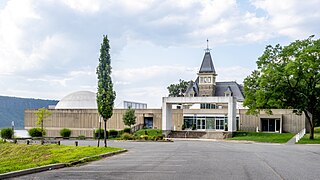
The Hudson River Museum, located in Trevor Park in Yonkers, New York, is the largest museum in Westchester County. The Yonkers Museum, founded in 1919 at City Hall, became the Hudson River Museum in 1948. While often considered an art museum by the public, due to the extensive collection of Hudson River School paintings, the museum also features exhibits on the history, science and heritage of the region.
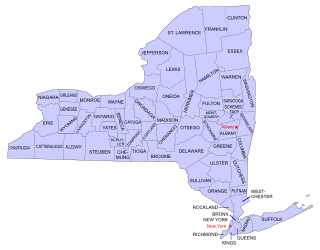
Buildings, sites, districts, and objects in New York listed on the National Register of Historic Places:
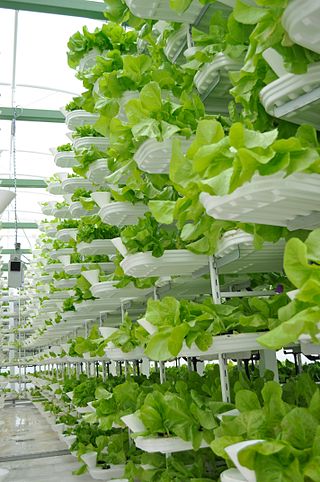
Vertical farming is the practice of growing crops in vertically stacked layers. It often incorporates controlled-environment agriculture, which aims to optimize plant growth, and soilless farming techniques such as hydroponics, aquaponics, and aeroponics. Some common choices of structures to house vertical farming systems include buildings, shipping containers, underground tunnels, and abandoned mine shafts.

The Saw Mill River is a 23.5-mile (37.8 km) tributary of the Hudson River in Westchester County, New York, United States. It flows from an unnamed pond north of Chappaqua to Getty Square in Yonkers, where it empties into the Hudson as that river's southernmost tributary. It is the only major stream in southern Westchester County to drain into the Hudson instead of Long Island Sound. It drains an area of 26.5 square miles (69 km2), most of it heavily developed suburbia. For 16 miles (26 km), it flows parallel to the Saw Mill River Parkway, a commuter artery, an association that has been said to give the river an "identity crisis."
Controlled-environment agriculture (CEA) -- which includes indoor agriculture (IA) and vertical farming—is a technology-based approach toward food production. The aim of CEA is to provide protection from the outdoor elements and maintain optimal growing conditions throughout the development of the crop. Production takes place within an enclosed growing structure such as a greenhouse or plant factory.
Water resources are natural resources of water that are potentially useful for humans, for example as a source of drinking water supply or irrigation water. 97% of the water on Earth is salt water and only three percent is fresh water; slightly over two-thirds of this is frozen in glaciers and polar ice caps. The remaining unfrozen freshwater is found mainly as groundwater, with only a small fraction present above ground or in the air. Natural sources of fresh water include surface water, under river flow, groundwater and frozen water. Non-natural or human-made sources of fresh water can include wastewater that has been treated for reuse options, and desalinated seawater. People use water resources for agricultural, industrial and household activities.
Building-integrated agriculture (BIA) is the practice of locating high-performance hydroponic greenhouse farming systems on and in mixed-use buildings to exploit synergies between the built environment and agriculture.
New York Sun Works, founded in 2004 by Ted Caplow, is a 501(c)(3) non-profit organization that uses hydroponic farming technology to educate students and teachers about the science of sustainability. Their Hydroponic Classroom program was inspired by NY Sun Works' first project, the renowned Science Barge; a prototype, sustainable urban farm and environmental education center previously housed on the Hudson River and now located in Yonkers under different ownership.

Theodore "Ted" Caplow is an American social entrepreneur, environmental engineer, and inventor. He is the founder of greenhouse science lab provider New York Sun Works and the co-founder of AgTech supply-chain disruptor BrightFarms. Caplow's pioneering work in urban agriculture and vertical farming began with the Science Barge in Yonkers, New York (NY). Caplow has also patented a Vertically Integrated Greenhouse. Caplow subsequently co-founded Caplow|Manzano in 2017 with Nathalie Manzano to pursue innovations in resilient housing design and sustainable building technology. As an academic, Caplow holds a Ph.D. in engineering from Columbia University and has published a series of peer-reviewed articles on water contaminant dynamics in the Hudson River Estuary, in addition to articles on Building-integrated agriculture.
Sundrop Farms is a developer, owner and operator of high tech greenhouse facilities which grow crops using methods which reduce reliance on finite natural resources when compared to conventional greenhouse production. Sundrop Farms opened its first pilot facility in Port Augusta, South Australia, in 2010. This facility was originally designed as a Seawater Greenhouse. However, significant technology changes led to the Sundrop System, and the dissolution of the joint venture with Seawater Greenhouse Ltd. Sundrop Farms commissioned an expanded 20 ha facility south of Port Augusta in 2016. Sundrop Farms has offices in London, UK and Adelaide, Australia. In October 2016, Sundrop Farms was operating greenhouses in Portugal, the United States and had another facility planned in Australia.

The Miami Science Barge was a floating marine laboratory and education platform docked in Museum Park, Miami, FL since 2016. The Barge, designed to help support a more sustainable city, had three main areas of focus: marine ecology and conservation, sustainability, and alternative agriculture. It is completely off-grid and off-pipe and provided approximately enough energy and food production to support an average American family. In its first year, over 3000 students came aboard to learn about the innovative technology on the Barge. The vessel opened to the public on Saturdays. The Miami Science Barge was conceived by Nathalie Manzano and designed by Manzano and Ted Caplow. They were inspired by the Science Barge built in 2006 by New York Sun Works, designed by Caplow. The vessels were of similar size and both had a sustainable technology focus, but they responded to very different local environments and housed differing technology and unique public education programs. The Miami Science Barge emphasized aquaculture. The Miami Science Barge was donated in April 2017 to the brand-new Philip and Patricia Frost Museum of Science, who took over operations. The Miami Science Barge is no longer in use.
Gotham Greens is an American fresh food and urban agricultural company founded and headquartered in the Brooklyn borough of New York City that grows local produce year-round in greenhouses, with its lettuces, herbs, salad dressings and sauces sold under its brand name. The company owns and operates nine hydroponic greenhouse facilities in the United States.















